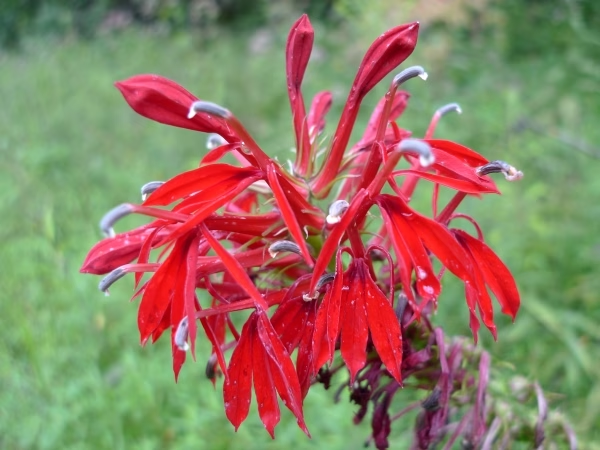
Cardinal Flower
Botanical Name
:
Lobelia cardinalis
Plant Type
:
Herbaceous Perennial (sometimes considered a biennial)
Seasons
:
Plant in spring or fall; blooms in summer to fall
Sun Level
:
Full sun (at least 6 hours daily) to part shade (prefers some afternoon shade in hot climates)
Ideal Soil Temperature for Planting
:
32 to 95°F (0 to 35°C)
Soil Type
:
Moist, well-drained soil, rich in organic matter
Hardiness Zones
:
3–9 (USDA)
Germination
:
Germination is relatively easy, usually within 10–14 days. Sow seeds indoors 6–8 weeks before the last frost
P.H. Level
:
Slightly acidic to neutral (6.0–7.0)
Water/Irrigation
:
Needs consistent moisture, especially during hot, dry periods
Fertilization
:
A light application of balanced fertilizer in spring can be beneficial
Habit
:
Upright, erect, unbranched (or sparsely branched)
Propagation
:
Seed, cuttings, or division (though division can be tricky)
Final Plant Height
:
2–4 ft
Spread
:
1–2 ft
Flowers
:
Bright red, tubular flowers arranged on tall spikes
Attracts
:
Hummingbirds (its primary pollinator!), butterflies
Uses
:
Hummingbird gardens, rain gardens, woodland edges, borders
Companions
:
Oher moisture-loving plants like ferns, hostas, and astilbes
Pruning
:
Deadhead spent flowers to encourage more blooms. Cut back stems in fall after the first frost
Toxicity
:
Considered toxic if ingested (contains lobeline alkaloids)
Pests
:
Slugs, snails, aphids
Diseases
:
Root rot (in poorly drained soil), powdery mildew
Fun Fact
:
The cardinalis name refers to the cardinal red color of the flowers
Confused With
:
Other Lobelia species, especially those with red flowers, though the flower shape is quite distinctive
Additional Info
:
It’s a favorite of hummingbirds. The bright red color attracts them
Botanical Name
:
Lobelia cardinalis
Plant Type
:
Herbaceous Perennial (sometimes considered a biennial)
Seasons
:
Plant in spring or fall; blooms in summer to fall
Sun Level
:
Full sun (at least 6 hours daily) to part shade (prefers some afternoon shade in hot climates)
Ideal Soil Temperature for Planting
:
32 to 95°F (0 to 35°C)
Soil Type
:
Moist, well-drained soil, rich in organic matter
Hardiness Zones
:
3–9 (USDA)
Germination
:
Germination is relatively easy, usually within 10–14 days. Sow seeds indoors 6–8 weeks before the last frost
P.H. Level
:
Slightly acidic to neutral (6.0–7.0)
Water/Irrigation
:
Needs consistent moisture, especially during hot, dry periods
Fertilization
:
A light application of balanced fertilizer in spring can be beneficial
Habit
:
Upright, erect, unbranched (or sparsely branched)
Propagation
:
Seed, cuttings, or division (though division can be tricky)
Final Plant Height
:
2–4 ft
Spread
:
1–2 ft
Flowers
:
Bright red, tubular flowers arranged on tall spikes
Attracts
:
Hummingbirds (its primary pollinator!), butterflies
Uses
:
Hummingbird gardens, rain gardens, woodland edges, borders
Companions
:
Oher moisture-loving plants like ferns, hostas, and astilbes
Pruning
:
Deadhead spent flowers to encourage more blooms. Cut back stems in fall after the first frost
Toxicity
:
Considered toxic if ingested (contains lobeline alkaloids)
Pests
:
Slugs, snails, aphids
Diseases
:
Root rot (in poorly drained soil), powdery mildew
Fun Fact
:
The cardinalis name refers to the cardinal red color of the flowers
Confused With
:
Other Lobelia species, especially those with red flowers, though the flower shape is quite distinctive
Additional Info
:
It’s a favorite of hummingbirds. The bright red color attracts them
Written by Nondiah Khalayi – https://www.linkedin.com/in/nondiah-khalayi/

